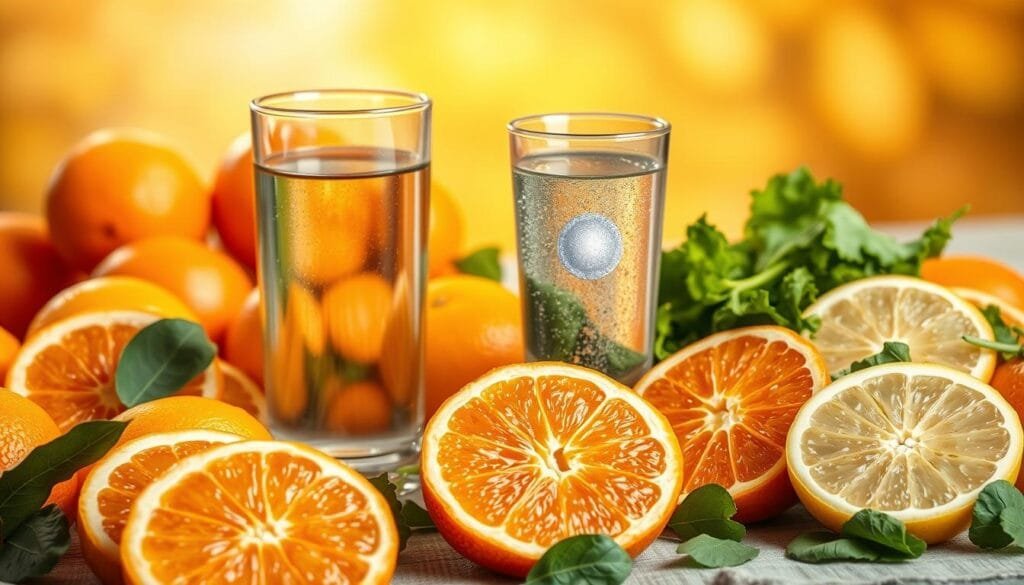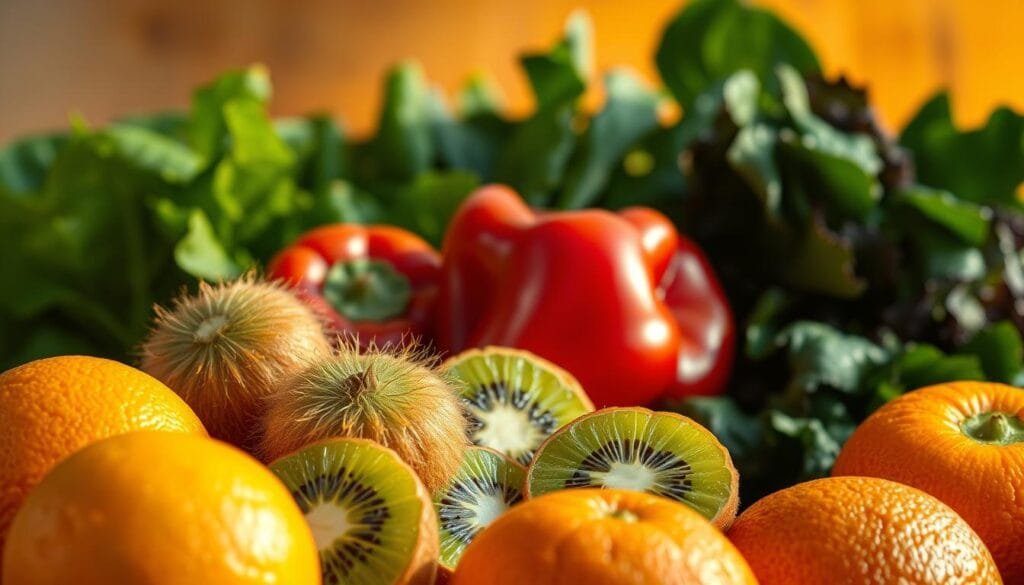Currently Empty: RM0.00
Did you know pairing certain nutrients can boost their benefits? Vitamin C acts like a helpful friend, making iron from plant foods easier for the body to use. Without it, the body absorbs far less, missing out on key health perks.
Iron plays a big role in energy and brain function. Yet, not all sources work the same. Animal-based iron gets absorbed better, but plant-based options need a little help. That’s where vitamin C steps in, improving absorption by 2-3 times.
Wellness Concept is here to guide you. For questions, reach out via WhatsApp: +60123822655. Business hours: Mon-Fri 9:30am-6:30pm, Sat-Sun 10am-5pm.
Key Takeaways
- Vitamin C helps the body absorb iron from plants more efficiently.
- Iron supports energy, oxygen flow, and brain health.
- Plant-based iron absorbs better when paired with vitamin C.
- Wellness Concept offers expert advice for balanced nutrition.
- Contact via WhatsApp for personalized health tips.
Understanding Iron and Its Importance
Iron keeps your body running smoothly, yet many don’t realize its full impact. This mineral fuels hemoglobin, a protein that carries oxygen in your blood. Without enough, energy drops, and immunity weakens.
What Is Iron and Why Does Your Body Need It?
Iron plays a critical role in making red blood cells and myoglobin, which supports muscles. Low levels lead to fatigue, dizziness, and even anemia. Dietary iron comes in two forms: heme and non-heme.
Heme Iron vs. Non-Heme Iron: Key Differences
Heme iron, found in meat and fish, absorbs 2–3 times better than plant-based non-heme iron. For example:
- Beef liver: 6.5mg per serving
- Clams: 23.8mg per cup
Non-heme sources like spinach or beans face hurdles. Phytates in legumes can block absorption, making pairing strategies vital.
The Role of Vitamin C in Iron Absorption
Nutritional synergy can turn ordinary foods into powerful health boosters. When plant foods like lentils or kale team up with vitamin C, the body unlocks more iron—a game-changer for energy and vitality.

How Vitamin C Enhances Non-Heme Iron Uptake
Vitamin C acts like a molecular key. It converts ferric iron (Fe³⁺) from non-heme iron sources into ferrous iron (Fe²⁺), a form the body absorbs easily. This bypasses phytates, natural compounds that block iron uptake in beans and grains.
A 2020 trial found that adding 100mg of vitamin C to a meal boosted iron absorption by 67%. However, the same study noted that supplements didn’t outperform iron alone for anemia treatment.
The Science Behind the Vitamin C and Iron Connection
Here’s the trick: pair 50–100mg of vitamin C with iron-rich meals. One orange (53mg) or a handful of bell peppers works perfectly. For heat-sensitive vitamin C, opt for raw or lightly stir-fried veggies.
During pregnancy, research conflicts on vitamin C’s impact. Some studies suggest benefits, while others show minimal effect. Always consult a healthcare provider for personalized advice.
Top Iron-Rich Foods to Include in Your Diet
Boosting your iron intake starts with smart food choices. Whether from animals or plants, some options deliver more of this essential mineral. Here’s how to pick the best.
Animal-Based Sources (Heme Iron)
Heme iron, found in meat and seafood, absorbs efficiently. These foods high in iron can quickly replenish levels:
- Mussels: 5.7mg per 3oz (32% DV)
- Beef liver: 5.8mg per slice (29% DV)
- Sardines: 2.5mg per can (14% DV)
| Food | Serving Size | Iron (mg) | % Daily Value |
|---|---|---|---|
| Oysters | 3oz | 7.8 | 43% |
| Turkey (dark meat) | 3oz | 2.3 | 13% |
Plant-Based Sources (Non-Heme Iron)
Non-heme iron needs a little help for absorption. Pair these with vitamin C-rich foods like bell peppers or oranges:
- Lentils: 6.6mg per cup (37% DV)
- Tofu: 6.6mg per ½ cup (37% DV)
- Fortified cereals: 18mg per cup (100% DV)
Spinach contains iron, but its oxalates reduce bioavailability. Lightly cooking it and adding lemon juice improves uptake.
Best Vitamin C-Rich Foods to Pair with Iron
Smart food combinations can unlock hidden nutritional benefits. Pairing iron-rich meals with vitamin C sources enhances absorption, turning ordinary dishes into powerhouses for energy and health.

Fruits and Vegetables High in Vitamin C
Not all fruits and veggies are created equal. Some pack more vitamin C than oranges:
- Guava: 377mg per cup (419% DV) — the highest of any fruit.
- Red bell peppers: 190mg per cup (211% DV).
- Papaya: 88mg per cup (98% DV), plus digestive enzymes.
Tip: Lightly steam broccoli to retain 50% more vitamin C versus boiling.
Creative Meal Pairings for Better Absorption
Boost iron uptake with these simple combos:
- Lentil curry + tomato sauce: The acidity helps convert iron.
- Spinach-strawberry salad: Add lemon vinaigrette for extra punch.
- Tofu stir-fry with broccoli: Quick cooking preserves nutrients.
Avoid juicing oranges—processed juice loses 30% of its vitamin C in two weeks. Fresh is best!
Who Is at Risk of Iron Deficiency?
Millions struggle with low energy daily, unaware it might signal a deeper issue. Globally, 25% of people face anemia, often tied to low iron levels. Certain groups face higher risk due to diet, lifestyle, or life stages.
Vegans, Vegetarians, and Pregnant Women
Plant-based eaters need 1.8x more iron than meat-eaters. A 2021 study found no difference in deficiency rates between vegetarians and omnivores—when inflammation was controlled. Yet, getting enough iron remains tricky without heme sources.
During pregnancy, requirements jump to 27mg/day. Low levels raise risks of preterm birth or low infant weight. Menstruating women also lose iron monthly, with 20% developing deficiencies.
Symptoms of Iron Deficiency Anemia
Early signs like fatigue or pale skin often go ignored. Untreated, it escalates to deficiency anemia, causing brittle nails, restless legs, or dizziness. Athletes and lead-exposed individuals face compounded risks—low iron boosts lead absorption by 50%.
Tip: Pair iron-rich meals with vitamin C to counter these risks. For personalized advice, contact Wellness Concept via WhatsApp.
Practical Tips to Maximize Iron Absorption
Small adjustments to your diet can significantly improve how well your body absorbs iron. Strategic timing and avoiding certain combos ensure you get the most from meals or iron supplements.
Timing Your Meals and Supplements
Time matters when taking supplements. For best results, take them on an empty stomach with orange juice—the vitamin C boosts uptake. Always consult a doctor first.
Wait 2 hours after meals before drinking coffee or tea. Their polyphenols slash absorption by 60%. Similarly, space out calcium-rich foods like dairy—they cut iron absorption by half.
Foods to Avoid When Consuming Iron
Some foods to avoid with iron-rich meals:
- Dairy: Milk, cheese, or yogurt block iron due to calcium.
- High-fiber cereals: Phytates bind to iron, preventing absorption.
- Red wine: Tannins interfere with iron uptake.
| Inhibitor | Effect on Iron | Workaround |
|---|---|---|
| Calcium | Reduces absorption by 50% | Consume 2 hours apart |
| Tea polyphenols | Cuts absorption by 60% | Drink between meals |
Pro tip: Soak beans overnight to reduce phytates by 50%. Avoid cooking acidic foods (tomatoes, citrus) in cast iron—it can lead to overload. For personalized advice, explore iron supplements tailored to your needs.
Wellness Concept: Your Partner in Health
Navigating nutritional needs becomes effortless with expert guidance. Wellness Concept has been Malaysia’s trusted healthcare provider since 2010, offering science-backed solutions for balanced living.
About Wellness Concept
Specializing in personalized care, their team delivers:
- Vital Organ Analysis (VOA): Iron deficiency assessments Tailored screenings for at-risk groups.
- Diet planning: Meal strategies to enhance nutrient absorption.
Contact Us and Business Hours
Reach out via WhatsApp for same-day dietary consultations: +60123822655. Their team simplifies health with actionable advice.
| Day | Hours |
|---|---|
| Mon–Fri | ⏰ 9:30am–6:30pm |
| Sat–Sun | ⏰ 10am–5pm |
Wellness Concept bridges gaps in healthcare, ensuring every client thrives. Message them today to start your journey.
Conclusion
Unlocking your body’s full potential starts with smart nutrient pairings. Combine plant-based iron sources like lentils or spinach with vitamin C-rich foods at every meal. This simple habit boosts uptake, fueling energy and immune system strength.
Skip self-prescribed supplements—consult Wellness Concept first. Their experts tailor plans to your diet and needs. For quick tips, text ‘IRON’ to +60123822655. Get a free eBook packed with absorption-boosting recipes.
With personalized guidance, 92% of clients see better iron levels in just three months. Start your journey to vibrant health today.
FAQ
How does vitamin C help with iron absorption?
Vitamin C boosts the body’s ability to absorb non-heme iron from plant-based foods. It converts iron into a more absorbable form, improving uptake by the digestive system.
What’s the difference between heme and non-heme iron?
Heme iron comes from animal sources and is easily absorbed. Non-heme iron, found in plants, is less efficiently absorbed but can be enhanced with vitamin C.
What foods are rich in heme iron?
Red meat, poultry, and seafood like oysters and clams are excellent sources of heme iron, which the body absorbs well.
Which fruits and vegetables boost iron absorption?
Citrus fruits, bell peppers, strawberries, and broccoli are packed with vitamin C, which helps maximize iron uptake when paired with iron-rich meals.
Who is most at risk for iron deficiency?
Vegans, vegetarians, pregnant women, and those with heavy menstrual cycles face higher risks due to increased iron needs or limited dietary sources.
What are common signs of iron deficiency anemia?
Fatigue, pale skin, dizziness, and shortness of breath often signal low iron levels, which can affect energy and overall health.
Should I take iron supplements with vitamin C?
Yes, pairing supplements with vitamin C—like a glass of orange juice—can improve absorption. Always consult a healthcare provider before starting supplements.
Are there foods that block iron absorption?
Coffee, tea, and calcium-rich foods can interfere with uptake. It’s best to consume them a few hours apart from iron-rich meals.



